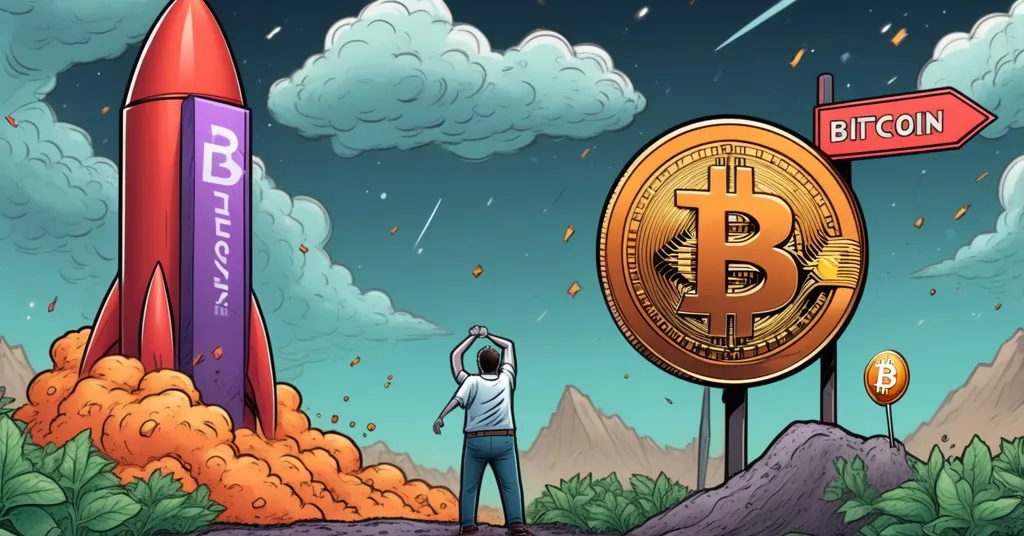Bitcoin Stalls at $96K as $0.035 DeFi Token Mutuum Finance Grabs 2026 Hype

Bitcoin Price Stalls Below $96,000 as $0.035 DeFi Altcoin Mutuum Finance Steals 2026 Spotlight
Bitcoin (BTC), the titan of the cryptocurrency world, is grinding to a halt below the $96,000 mark after a meteoric rise to nearly $126,000, grappling with a liquidity crunch and institutional pullbacks. Meanwhile, a lesser-known DeFi project, Mutuum Finance (MUTM), priced at just $0.035, is catching fire in its presale phase, promising sky-high returns and positioning itself as a potential dark horse for 2026 gains.
- Bitcoin struggles below $96,000 amid liquidity crisis and ETF outflows.
- Analysts predict a possible BTC drop to $89,600 if support levels fail.
- Mutuum Finance raises $18.8 million in presale, projecting 500% ROI.
Bitcoin’s Battle at $96,000: Liquidity Crunch and ETF Outflows
Bitcoin has been the benchmark for crypto markets since its inception, often seen as digital gold due to its finite supply and unmatched network security. But right now, it’s stuck in a rut. After hitting an all-time high of nearly $126,000 earlier this year, BTC is consolidating below $96,000, unable to breach this critical resistance zone. This isn’t just a minor speed bump—there’s a serious liquidity crisis unfolding. Bitcoin spot ETFs, which are investment vehicles allowing traditional finance players to gain exposure to BTC’s price without owning the asset directly (think of it as betting on gold prices without holding the metal), are experiencing some of the worst outflows in their history. Reports suggest massive sell-offs from major funds, signaling that Wall Street is stepping back after the recent rally.
Institutional investors, the deep-pocketed players who often drive market momentum, are labeling this a “bear regime”—a phase where prices trend downward, and pessimism reigns. They’re pointing to a structural repricing, which is a fancy way of saying the market is stabilizing after a rapid run-up, often fueled by profit-taking or reduced buying pressure. Add to that the unwinding of leverage—high-risk bets using borrowed funds being liquidated—and you’ve got a recipe for selling pressure. If key support levels between $93,000 and $95,000 crumble, analysts warn of a potential slide to $89,600. That’s not just a dip; it’s the kind of drop that tests even the staunchest HODLers’ resolve, making them double-check their wallet balances.
But let’s not paint this as pure doom and gloom. Bitcoin has weathered storms like this before. Post-2017 and 2021 bull runs, we saw similar corrections after all-time highs, often followed by periods of consolidation before the next leg up. Macro factors are also at play—rising interest rates, regulatory murmurs from bodies like the SEC, and geopolitical uncertainty could be spooking institutional money. On the flip side, there’s potential for a rebound. The upcoming Bitcoin halving, which slashes mining rewards and historically tightens supply, could ignite fresh interest. Plus, whispers of whale accumulation—big players buying at lower prices—might signal a bottom. Whether BTC holds or folds at these levels could dictate the tone for the entire crypto market heading into the next quarter.
Mutuum Finance: $0.035 DeFi Token Sparks 2026 Hype
While Bitcoin slugs it out in the heavyweight division, a scrappy contender in the DeFi space is making waves. Mutuum Finance (MUTM), currently in the sixth phase of its presale with tokens priced at $0.035, is turning heads with some eye-popping numbers, as highlighted in recent crypto market updates. For the uninitiated, DeFi—or decentralized finance—refers to blockchain-based systems that replicate financial services like lending, borrowing, and trading without intermediaries like banks. It’s finance on autopilot, powered by smart contracts (self-executing code on the blockchain) that cut out the middleman. Mutuum is riding this revolutionary wave, having already pulled in over 18,080 holders and raised a hefty $18.8 million. That’s serious traction for a project still in its early stages.
The numbers keep getting juicier. MUTM’s token price has surged 250% from its initial $0.01, and the upcoming seventh presale phase will push it above $0.040—a 20% bump. The project is dangling a tantalizing 500% return on investment (ROI) once the price hits $0.06, a target they claim is within reach. They’re also tossing in perks like hassle-free token purchases via credit card with no limits and a $100,000 giveaway split among 10 winners at $10,000 each. It’s the kind of marketing that grabs eyeballs, especially when Bitcoin is mired in uncertainty. The narrative is straightforward: while BTC faces headwinds, altcoins like MUTM are pitching themselves as the high-growth bets for risk-hungry investors.
But let’s slam on the brakes before we get carried away. What exactly does Mutuum Finance do? Public information is thin, but assuming they’re targeting a niche like decentralized lending or yield farming (earning rewards by staking crypto), they could offer real utility—think of it as a bank-free way to earn interest or borrow funds. If they deliver, Mutuum could push DeFi’s mission of dismantling financial gatekeepers a step further. However, without clear details on their roadmap, team credibility, or tokenomics—think total supply, vesting schedules, or team allocations—it’s hard to separate hype from substance. A large team allocation, for instance, often signals a future dump risk. Compared to early Ethereum presales that delivered, or countless 2017 ICOs that vanished with investors’ cash, Mutuum’s story is still unwritten. Projections of 500% returns sound seductive, but let’s not pretend they’re more than a crystal ball guess. Show us the utility, not just the numbers.
The Bigger Picture: Bitcoin Stagnation Fuels Altcoin Frenzy
Zooming out, the contrast between Bitcoin’s current grind and Mutuum’s presale momentum mirrors a recurring dynamic in crypto markets. When BTC falters or consolidates, capital often flows into alternative assets—altcoins, DeFi protocols, or whatever shiny new thing promises outsized gains. We saw this in 2021 when Bitcoin sideways movement sparked pumps in tokens like Solana and Avalanche. Today, with Bitcoin’s price analysis pointing to uncertainty, investors are hunting for the next big thing. DeFi as a sector continues to attract attention, with total value locked (TVL)—the amount of crypto staked in these protocols—still hovering in the billions despite bearish cycles. Major players like Uniswap (decentralized trading) and Aave (lending) have proven the model can work, but for every success, there are dozens of failures.
As a Bitcoin maximalist at heart, I’ll argue that BTC remains the only true store of value in this space. Its censorship resistance, decentralized network, and hard-capped supply of 21 million coins make it the bedrock of crypto’s promise to upend traditional finance. No altcoin matches its battle-tested resilience. That said, Bitcoin isn’t built to fill every niche. DeFi projects, if they pan out, can tackle specific use cases—think peer-to-peer lending or automated yield generation—that BTC was never meant to address. The trick is separating the wheat from the chaff, especially in a presale landscape often littered with scams or vaporware. Mutuum might be a contender, or it might be another flash in the pan. Only time will tell.
Risks and Realities: Navigating Presale Hype vs. Market Fundamentals
Let’s cut through the noise with some harsh truths. Presales like Mutuum Finance are a gamble, plain and simple. On one hand, they offer early adopters a shot at ground-floor prices before a token (hopefully) skyrockets. On the other, they’re speculative as hell, often unregulated, and can vanish overnight—taking your money with them. The lack of transparency around many of these projects is a glaring red flag. No whitepaper? No audited code? No proven team? Then you’re basically throwing darts blindfolded. Even with Mutuum’s impressive $18.8 million raise, there’s no guarantee they’ll deliver or even list on a major exchange. Dig into the details yourself—hype doesn’t equal proof.
Bitcoin’s struggles, meanwhile, are a reminder that even the most robust crypto isn’t immune to market cycles. The liquidity crunch and ETF outflows reflect broader caution, possibly tied to macroeconomic pressures like interest rate hikes or fears of tighter regulation. Yet, BTC’s long-term fundamentals—its decentralized ethos, its role as a hedge against inflation—remain unshaken. The question is whether short-term pain will give way to renewed strength, or if we’re in for a deeper correction. As Bitcoin tests its mettle at $96,000 and Mutuum rides a wave of presale optimism, the crypto market remains a battleground of resilience versus speculation. Stay sharp, because in this game, complacency is the real killer.
Key Takeaways and Questions for Reflection
- What’s driving Bitcoin’s struggle below $96,000?
A liquidity shortage, massive outflows from Bitcoin spot ETFs, and institutional profit-taking after the $126,000 peak are halting BTC’s momentum. - Is a Bitcoin crash to $89,600 really on the horizon?
It’s possible—if support levels between $93,000 and $95,000 break, analysts see a sharp decline fueled by bearish sentiment and capital flight. - Why is Mutuum Finance generating buzz for 2026 gains?
With $18.8 million raised in presale, a 250% price jump to $0.035, and a projected 500% ROI, MUTM is positioned as a high-potential DeFi investment. - How does Bitcoin’s stagnation impact the broader crypto market?
It often shifts capital to altcoins like MUTM, fueling speculative bets, but also raises fears of a wider downturn if confidence erodes further. - Should investors abandon Bitcoin for DeFi altcoins during slumps?
Not entirely—while altcoins may offer growth, they’re riskier; diversification balances Bitcoin’s stability with speculative upside. - What risks come with DeFi presales like Mutuum Finance?
They’re highly speculative, often lack oversight, and can fail or turn out to be scams—investors must weigh hype against the real chance of total loss. - Can DeFi projects rival Bitcoin in the long term?
Unlikely as a store of value, but they could complement BTC by solving specific financial problems like lending or yield generation.



